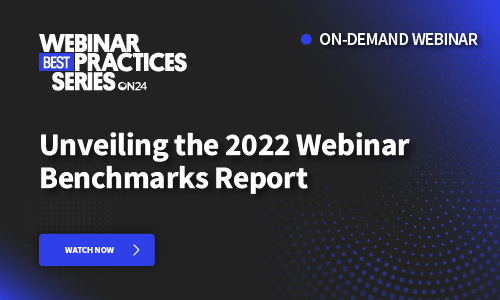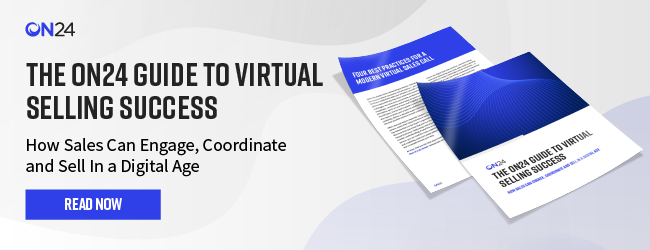The Year of More

This is the year of more
In the past two years, everything has changed; how we connect, how we work and how we sell. I don’t have to explain it, you know it. But digital transformation wasn’t a band-aid. The global pandemic simply accelerated what was already coming, a digital-first world. It just got here a little quicker.
Now marketers talk about the approaching “new normal,” but I think that what they expect is a slightly modified version of the old normal.
It’s not happening. Those companies that try to fall back into old marketing habits, using established technologies and channels, in traditional ways, will be left behind. Simply put, to drive pipeline and revenue in this “new now,” we have to do more.
Audiences expect more

Our audiences have changed. We have all changed. In the past few years, we have used digital channels to connect to our families, co-workers and the world around us in ways that we never imagined.
And because of that, audiences come with new expectations for what a digital engagement can be. They will no longer settle for, or sit through, passive experiences where all they can do is sit and watch, or read.
Whether they are visiting your website, attending a webinar or a virtual event, audiences today want interactive, content-rich experiences that they can actively participate in. They want to be engaged.
It turns out that “digital fatigue” was just code for boring experiences. Today, there is simply no tolerance for bad marketing. People want experiences that are authentic, helpful, and uniquely human.
And that’s a good thing. This doesn’t mean that our marketing channels are bad, it just means that we need to rethink how we use them. A digital experience can be anything. It might be a talk show, a news-style show, an awards show, or a demo.
A webinar is not a webinar, it’s an experience. A virtual event is an experience. Even a landing page can be experiential. The question is are you creating experiences that your audiences will love?
Marketers must do more

The old demand gen models for driving prospects through a prescribed journey are no longer realistic.
Our audiences will be self-educating their way through their own journey, on their own terms. They expect you to magically know them before you have even met them. And they want content experiences that are tailored to their unique needs at any given time.
That’s a lot to ask. And that’s why we have to do more.
 Modern marketing has been defined by two distinct poles: broad-based programs for lead generation and account-based marketing programs for highly targeted selling motions. It’s time to fill in the middle.
Modern marketing has been defined by two distinct poles: broad-based programs for lead generation and account-based marketing programs for highly targeted selling motions. It’s time to fill in the middle.
A monthly thought leadership webinar might be replaced by three or four different serialized webinar programs, each one speaking to a different audience or addressing a unique use case.
As opposed to doing one or two big events each year, the flexibility of digital event solutions now enables us to create streams of event experiences, from virtual roadshows to industry-specific roundtables, to virtual workshops for targeted personas.
Wherever our prospects go, whatever they need, they should be met with an engaging digital experience.
Our sales teams need more

If you think that your job got harder as a marketer over the past few years, try stepping into the shoes of your salespeople. They are in the business of building relationships at a time when they literally can’t even get in the door.
Some reps have gone two years without being able to make a single in-person sales call. If that wasn’t hard enough, modern buyers don’t want to engage with salespeople sometimes right up until it’s time to talk pricing.
They need help.
 Delivering “leads” (aka: names) to sales is no longer enough. It hasn’t been in ages. What we call a well-qualified lead is usually a person that has demonstrated “interest” by visiting the website or filling out a form for a piece of content or to attend an experience.
Delivering “leads” (aka: names) to sales is no longer enough. It hasn’t been in ages. What we call a well-qualified lead is usually a person that has demonstrated “interest” by visiting the website or filling out a form for a piece of content or to attend an experience.
But there is a huge difference between interest and intent. And frankly, even a form fill doesn’t really mean someone is interested.
A digital strategy that puts audience engagement at its core, delivers something far more valuable: actionable, first-person data.
In a virtual experience where a prospect is asking questions, responding to polls, downloading content, requesting demos or clicking on other CTAs, we can learn so much more about them. Instead of giving leads to sales, you are delivering a prospect profile. This enables sales to continue a conversation, not try to start one.
Sales also needs new ways to engage and today, most of the selling is happening in the marketing. Smart companies are not waiting for the traditional marketing to sales handoff.
Modern webinars and events integrate sales right into the experience by enabling virtual sales chats, 1:1 breakout rooms, and appointment setting…in real-time. Now, the marketing and selling happen together, in concert.
More, more, more

More? Well, this sounds like a lot more work. Yes. It. Does.
We need to create more digital experiences than ever; experiences for every audience and every need. And those experiences need to be awesome. But isn’t this what we got into marketing for in the first place? To create awesome? The “new normal” shouldn’t be normal at all. It needs to be better.
And I, for one, couldn’t be more excited.